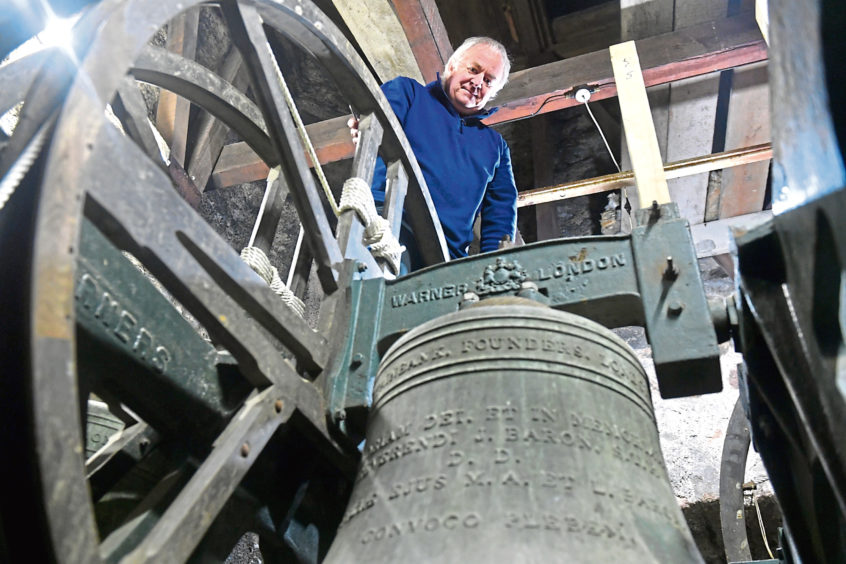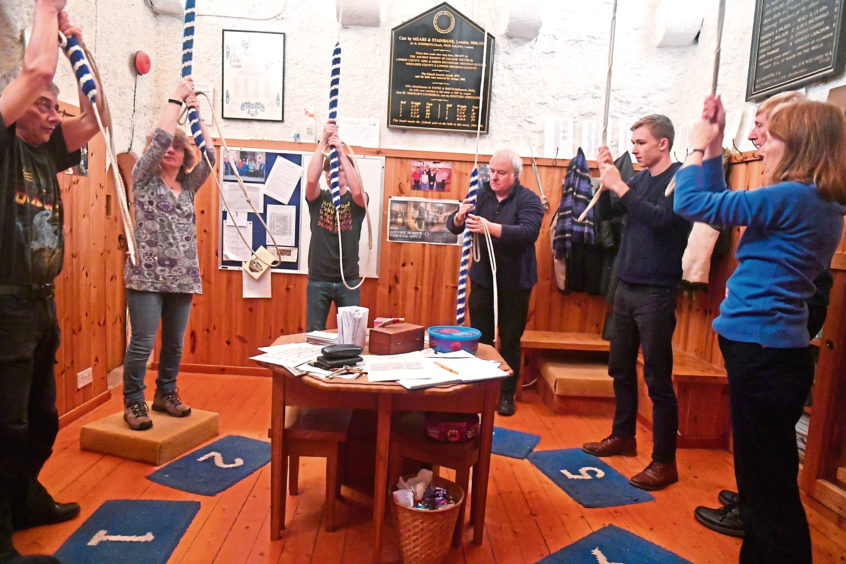St Machar’s Cathedral is cloaked in darkness, with only the faint glow from a lantern at the gateway.
The occasional sound of footsteps and the sharp ting of a bicycle bell echo on the cobbles of Old Aberdeen, as students cut through Seaton Park on their way home.
The historic building seems at peace in the gloom, and frost has already started to settle on the winding paths of the graveyard.
“It’s not really the sort of place you’d come in the evening,” says Ian Talboys, his breath creating small plumes in the night air.
He fishes a set of keys from his pocket and unlocks the solid door, before threading his way past the pews.
The beauty of the three stained-glass windows is hidden from view, although 25,000 tourists visit the renaissance site each year.
The silence is oddly comforting; a gentle hush that has settled into the tread of a steep, twisting staircase.
Ian opens the remaining door to reveal a circular room, where eight thick ropes hang from the wooden ceiling.
The public rarely catches a glimpse of this simple space, which is in marked contrast to the grandeur of the nave and altar below.
We are, in fact, standing in the heart of the cathedral, albeit not geographically.
For this is the ringing chamber, or to put it simply – the operations room for the eight bells of St Machar’s.
Be it a joyful peel or sorrowful knell, church bells have been rung across the country for hundreds of years.
They were silenced in Britain during the Second World War, before ringing out in celebration with the arrival of peace.
Bells are not just the voice of a church and a community; they are rung in times of national celebration, and are muffled for grief and mourning.
An unsung team of volunteers makes sure that the bells of historic St Machar’s do not fall silent, despite their turbulent history.
Led by Ian, who has been the tower captain for almost 20 years, the dedicated group meets for practice every Monday evening.
A wide range of people give up their spare time until 9.30pm, and the youngest member is aged 17.
“This is known as the ringing chamber, and it is at the west end of the cathedral,” says Ian.
“We have 25 people in total; the bells are two floors above us.
“There are only a small number of towers in Europe, with 21 in Scotland.
“Most ringing towers have several floors, the most important is the belfry.
“The belfry is where the bells are hung.”
Ian must close the shutters in the belfry before the session can commence, meaning much of the noise will be contained within the cathedral.
We ascend another staircase before crawling through a narrow archway, and clamber up a steep ladder to where the bells reside.
Ian hoists himself through the hatch with ease, and balances on the framework of beams.
Shutters firmly closed, the session gets under way.
“The big bell weighs three-quarters of a ton,” Ian says.
“Part of the challenge to bell-ringing is learning to lift the rope at the right time.
“If you’re not careful, you can be lifted off your feet or get rope burn.
“In the ringing chamber, the ropes come down in order of bell size.
“The fluffy coloured section is called a Sally on each rope, and ringers stand in a circle facing inwards.”
Bell handling must be mastered before call changes and method ringing can begin.
Ian has been ringing bells for 35 years, and believes it is easier to teach the art to non-musicians.
“It all started when I was living in this little village,” recalls Ian, who is also head of the countryside ranger service for Aberdeen City Council.
“The vicar was moving on to a new parish, and I was asked to come along to take some pictures.
“The bell-ringers said they wouldn’t pose unless I had a go at bell-ringing too.
“You could say I was conned into it, as I’ve been bell-ringing ever since.
“There is a degree of physicality to it, but you don’t need to be really fit or strong.
“It’s all down to technique, which is why learning to ring is a slow process.
“One thing you do need is good co-ordination.
“A good memory and sense of rhythm also helps.
“Bell-ringing is a tradition and it’s a special thing to be part of.
“I enjoy the challenge and the social aspect, alongside teaching people.”
The bells ring out for the midnight service on Christmas Eve, and the team also make an appearance on the morning of Christmas Day.
“We are always looking for more people,” says Ian.
“St Mary’s in Huntly is planning to start up a bell-ringing group, so we’re hoping to inspire more people to come forward.”

